At home, thuja propagation by cuttings is best done in the fall. Experienced gardeners recommend this. There are several ways to root. They do not require special skills and tools. In 2-3 years, it is real to grow thuja seedlings for your garden.
Content
- 1 How to breed thuja
- 2 What are the benefits of grafting?
- 3 Cons of cuttings
- 4 How to choose branches for cuttings?
- 5 When to cut a thuja: optimal timing
- 6 How to cut thuja cuttings
- 7 How to prepare thuja cuttings for rooting
- 8 Soil preparation
- 9 Direct rooting process
- 10 A non-standard way: rooting cuttings in potatoes
- 11 Is it possible to grow cuttings in water?
- 12 Growing cuttings in the substrate
- 13 Growing cuttings in sphagnum
- 14 Care for planted thuja cuttings before planting in a permanent place
- 15 Reviews
How to breed thuja
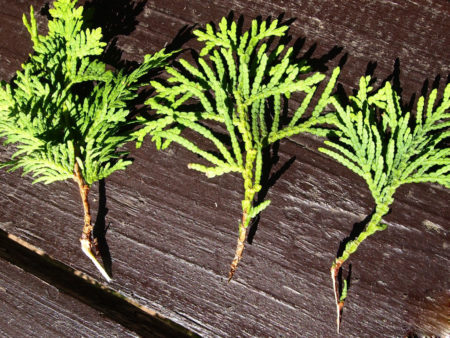 Buying a ready-made thuja seedling is the easiest, fastest and most reliable way to propagate an evergreen shrub (tree). The cost of evergreens is not small, so gardeners prefer to grow seedlings for hedges, garden compositions on their own, propagating them:
Buying a ready-made thuja seedling is the easiest, fastest and most reliable way to propagate an evergreen shrub (tree). The cost of evergreens is not small, so gardeners prefer to grow seedlings for hedges, garden compositions on their own, propagating them:
- seeds;
- cuttings.
The first method is time consuming. The result - a full-fledged thuja seedling during seed propagation can be obtained only after 5-6 years. And although such a plant when transplanted into the garden is practically not sick and quickly adapts, gardeners prefer to propagate by cuttings.
What are the benefits of grafting?
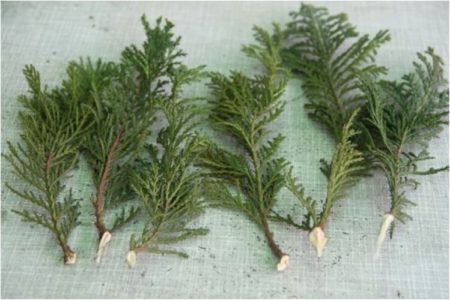 The main plus of this technology – obtaining a fully formed plant in 3 years. If you plant cuttings in the fall, you can decorate the garden with conifers almost 2 times faster than when propagated by seeds. Preservation of varietal traits is another important advantage of the method.
The main plus of this technology – obtaining a fully formed plant in 3 years. If you plant cuttings in the fall, you can decorate the garden with conifers almost 2 times faster than when propagated by seeds. Preservation of varietal traits is another important advantage of the method.
Having mastered the method of propagation by cuttings, the gardener receives two advantages:
- preserves the decorative form of the parent plant;
- receives a thuja seedling in a short time.
Cons of cuttings
Cuttings take root for a long time. This is the main disadvantage of this method. According to statistics, with full observance of the methodology, only 70% of the total number of planted seedlings survives. There are other difficulties. The thuja obtained from the cuttings is more sensitive to sudden changes in the weather and requires better care.
How to choose branches for cuttings?
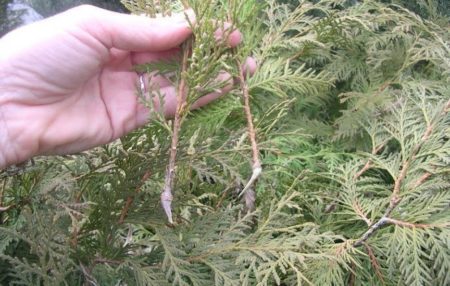 It is necessary to choose healthy trees in order to propagate thaw by cuttings. Inspect the branches and trunk. External symptoms indicate plant fungal diseases:
It is necessary to choose healthy trees in order to propagate thaw by cuttings. Inspect the branches and trunk. External symptoms indicate plant fungal diseases:
- brown shoots;
- brown, dark, gray needles on the shoots;
- crumbling needles;
- growths on the trunk.
In a healthy pyramid-shaped tree (bush), side branches are suitable for propagation, in other varieties of conifers apical shoots are suitable for cuttings.
When to cut a thuja: optimal timing
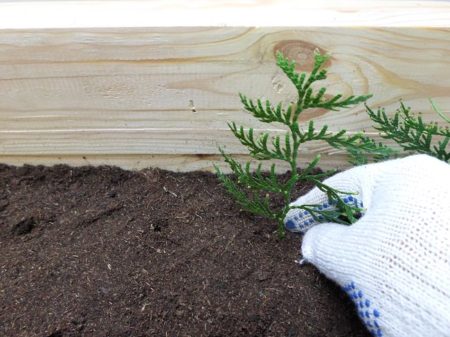 Experienced gardeners prefer to cut thuja in the fall. At this time, sap flow slows down. The percentage of survival of planting material is high. In the middle lane, shoots are harvested in October; November is more suitable for the southern regions.
Experienced gardeners prefer to cut thuja in the fall. At this time, sap flow slows down. The percentage of survival of planting material is high. In the middle lane, shoots are harvested in October; November is more suitable for the southern regions.
You can hold the workpiece in the spring. Dates are limited. Viable cuttings cut from late March to late April. If high-quality material is selected, then the cutting time (autumn, spring) has little effect on the result. The shank should be lignified, the optimal shoot age is 2 years, in extreme cases, it can be 3-year-old branches.
How to cut thuja cuttings
A shoot of 30-50 cm in length is cut from a tree.For cuttings, 10 or 15 centimeter branches growing on it are suitable. They can be obtained from several 2-3 year old branches at once. They work with hands. Secateurs are used to shorten the heel.
The heel is a piece of last year's wood. It is formed when a twig is torn off (from top to bottom) from the main shoot. The presence of wood at the bottom of the handle is mandatory. It contains nutrients that the plant will use to form roots.
How to prepare thuja cuttings for rooting
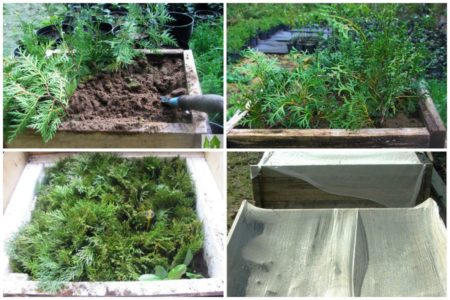 Before planting cuttings for rooting, the following manipulations are performed on them:
Before planting cuttings for rooting, the following manipulations are performed on them:
- cut the lower branches;
- shorten the remaining needles;
- the heel is densely powdered with root.
If they want to plant the next day, then instead of dusting the preforms are kept for 12 hours in a stimulant solution (Kornevin, Epin).
Soil preparation
A shallow rectangular container is filled with a light soil mixture. To prepare it take:
- fertile garden land (1 part);
- peat (1 part);
- river sand (1 part).
The sand is boiled for at least 5 minutes before use. The finished soil mixture is shed with 3% manganese solution.
Direct rooting process
The soil mixture in the container is leveled. With an interval of 5 cm, holes are made with a depth of 3-4 cm, they should not be vertical. Make them at an angle of 45 °. The prepared cuttings are stuck in the soil and pressed tightly.
The earth is watered in 2 sets. After the first, it settles; after the second, it is well moisturized. A mini-greenhouse is created from the film above the container to create a suitable microclimate. Capacity put on the north window. Lighting for cuttings is necessary, but direct sunlight can do much harm.
A non-standard way: rooting cuttings in potatoes
There are many nutrients in the potato tuber. They will come in handy at the initial stage of the formation of the root system. Healthy potatoes with firm, fresh pulp are suitable for rooting. The rooting process is carried out as follows:
- tubers are washed;
- all eyes carefully cut out;
- Using a long, thick nail, make indentations about 4 cm long;
- Thuja cuttings are inserted into the resulting holes.
Potatoes are placed in a container, sprinkled with a layer of fertile substrate. Each stalk is covered with a bottle of transparent plastic. Her bottom is cut off, and the tire is twisted.
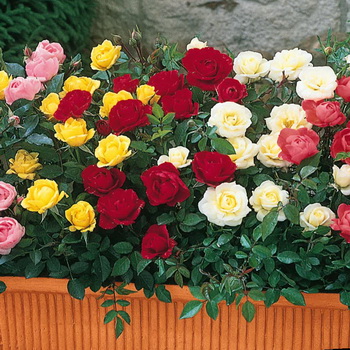 You may be interested in:
You may be interested in:Is it possible to grow cuttings in water?
Gardeners do not recommend germinating branches in jars of water. The method is simple to implement, but the seedlings are frail. This is because there are few nutrients in the water. The rules to be followed when growing thuja cuttings in water:
- put 1, maximum 3 branches in one container;
- pour water so that it only covers the heels;
- add water, but do not change.
The needles must be dry, if moisture gets on them, they can rot and the stalk will die.
Growing cuttings in the substrate
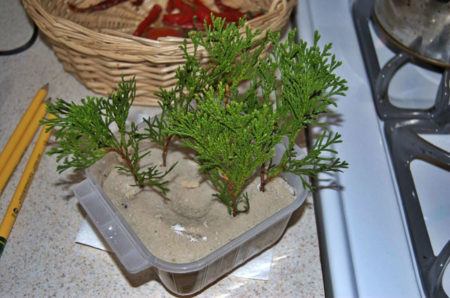 The substrate should be fertile and loose, so that enough nutrients and oxygen are enough to form the roots. Low capacity required. At the bottom, it is necessary to drill holes for the outflow of excess water.
The substrate should be fertile and loose, so that enough nutrients and oxygen are enough to form the roots. Low capacity required. At the bottom, it is necessary to drill holes for the outflow of excess water.
The first layer is poured drainage. Small pebbles, crushed stone, expanded clay are suitable for this purpose. The second layer is a fertile mixture. It is prepared a week before planting from garden soil (1 part) and peat (1 part). The soil must be disinfected with a solution of manganese.
The ends of the cuttings (heels) are lowered for 12 hours into the Kornevin solution.They are stuck into the soil to a depth of 3-4 cm at an angle of 45 °. The soil is watered. The entire surface is sprinkled with a thin layer of sand, it is moistened with a sprayer.
The container is covered with a film and placed in a room where the temperature is maintained at 18-22 ° C. Lighting provides a long, but not bright. Thuja propagation by cuttings in the substrate is carried out in the winter.
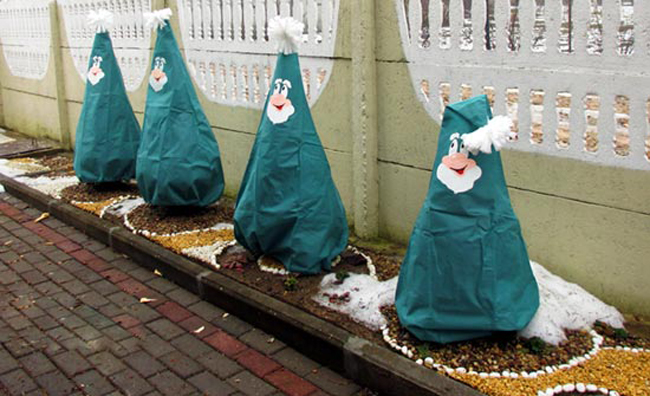 You may be interested in:
You may be interested in:Growing cuttings in sphagnum
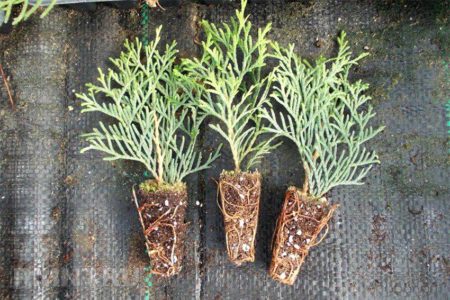 Sphagnum is peat moss. It has high hygroscopicity, so rooting thuja cuttings in it is very convenient. Moisture from it does not evaporate, it contains nutrients. In addition, it has bactericidal properties, stops the development of fungal infection.
Sphagnum is peat moss. It has high hygroscopicity, so rooting thuja cuttings in it is very convenient. Moisture from it does not evaporate, it contains nutrients. In addition, it has bactericidal properties, stops the development of fungal infection.
Sphagnum 3 hours soaked in water, then it is laid out on a cloth. The canvas is taken wide enough, the moss is laid a strip along the entire length. It should cover ½ part of the width. The prepared cuttings are laid out, the heels are immersed in moss.
The second half of the tissue is placed on top of the sphagnum. The upper part of the cuttings with needles should be on top. The canvas is being folded. It turns out not a tight roll. It is placed in a transparent plastic bag. They hang it in a bright, moderately warm room and wait for the roots to appear.
Care for planted thuja cuttings before planting in a permanent place
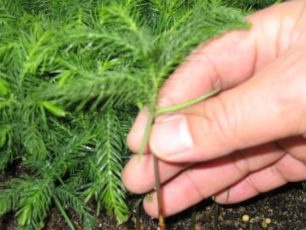 To grow rooted cuttings, a ridge is prepared. Choose a suitable place for her. At noon, it should be in openwork partial shade and always in the wind. Peat and sand are added to the soil. The approximate ratio of the soil mixture:
To grow rooted cuttings, a ridge is prepared. Choose a suitable place for her. At noon, it should be in openwork partial shade and always in the wind. Peat and sand are added to the soil. The approximate ratio of the soil mixture:
- garden land - 2 parts;
- river sand - 1 part;
- peat - 1 part.
Cuttings planted in autumn have good roots by spring. In the spring after the end of the frost, they are planted in the school. In summer, the soil is regularly watered, weed is removed, and the soil is shallow loosened. With the onset of cold weather, the ridge is bombarded with spruce branches, several layers of covering material. Take shelter in the spring. Thujas are transplanted into the garden after 2-3 years.
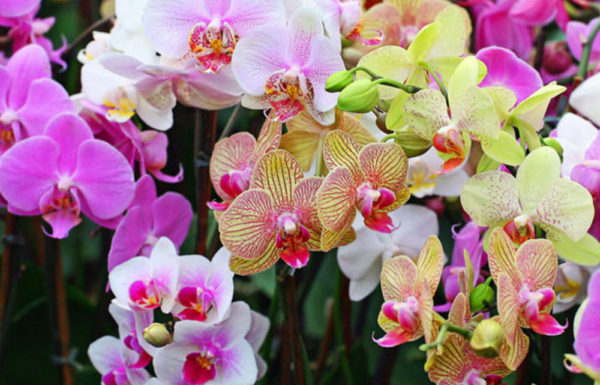 You may be interested in:
You may be interested in:In landscape design, thuja is used to create hedges, design garden paths. Phytoncides, which are released by the coniferous plant, improve the microclimate in the garden. The original shape of the crown (ball, cube, prism), formed by the gardener, makes the landscape exquisite.
Reviews
Alena, 34 years old, Moscow region
I cut the branches of thuja branches in the spring. I take larger cuttings (up to 20 cm) and always with a heel. I put them in a container under the film. By autumn, they form good roots, I transplant them into the garden. I do not use stimulants, there are no problems with rooting.
Ekaterina, 47 years old, Moscow
It is easy to propagate thuja with cuttings. I first dunk them in the ashes, and then plant them. I take only good soil, and pour 3 cm of sand on top. I cover with banks. After the cuttings take root, regularly water and feed.
Svetlana, 43 years old, Moscow
For several years now, thuja seedlings have been growing in pots. I don’t know the variety. The branch broke on the occasion. I stuck it in the pots, covered it with packages. All took root. They all grow in the same pots. There is not enough time to transplant to the garden.

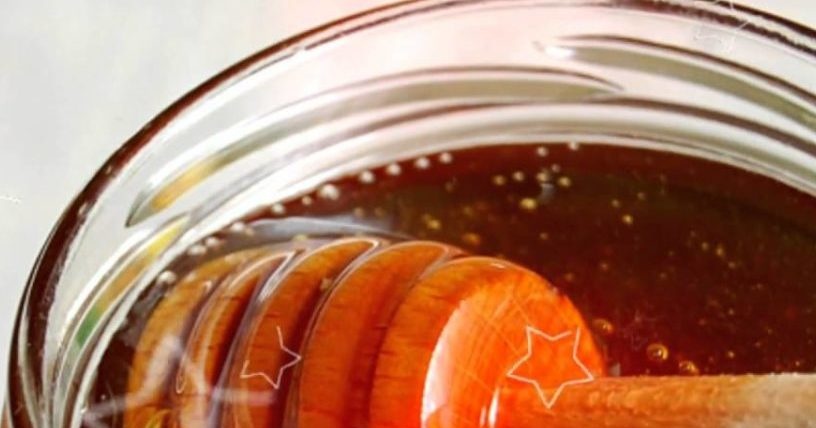
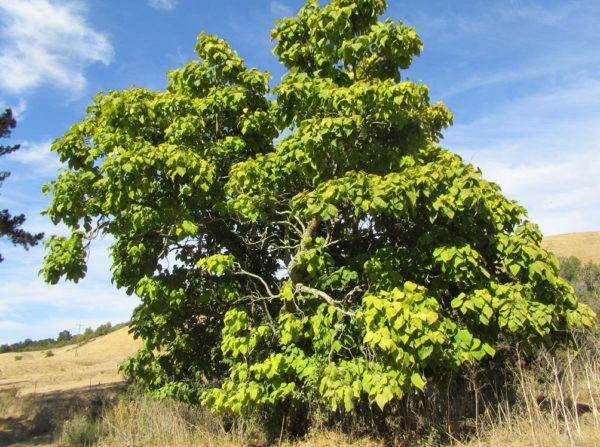
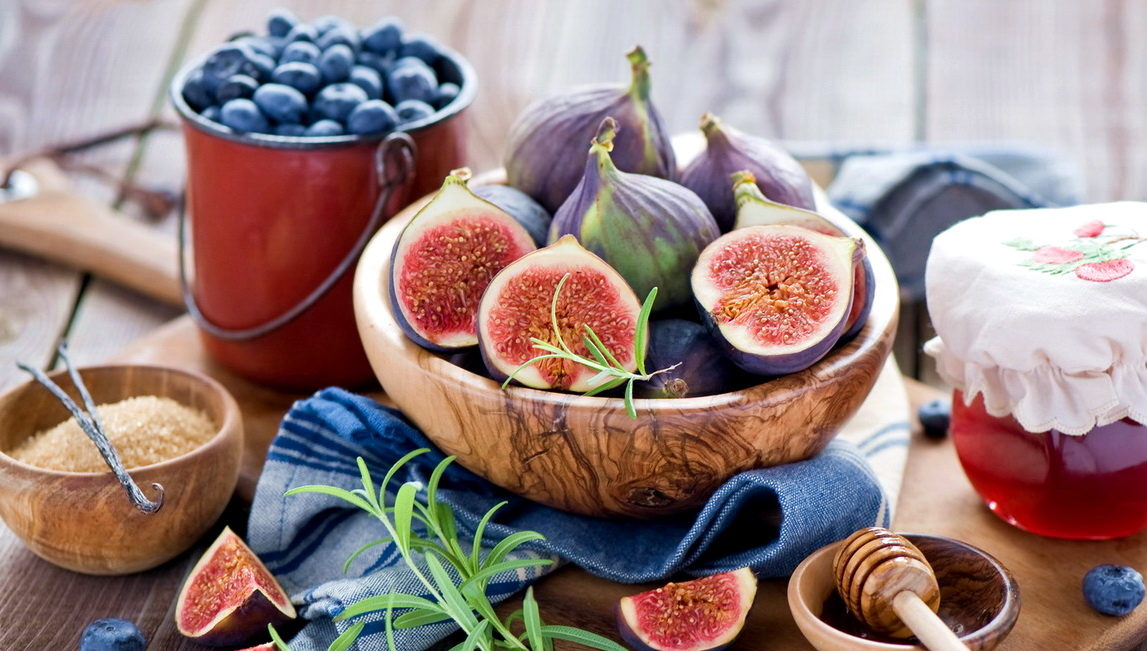
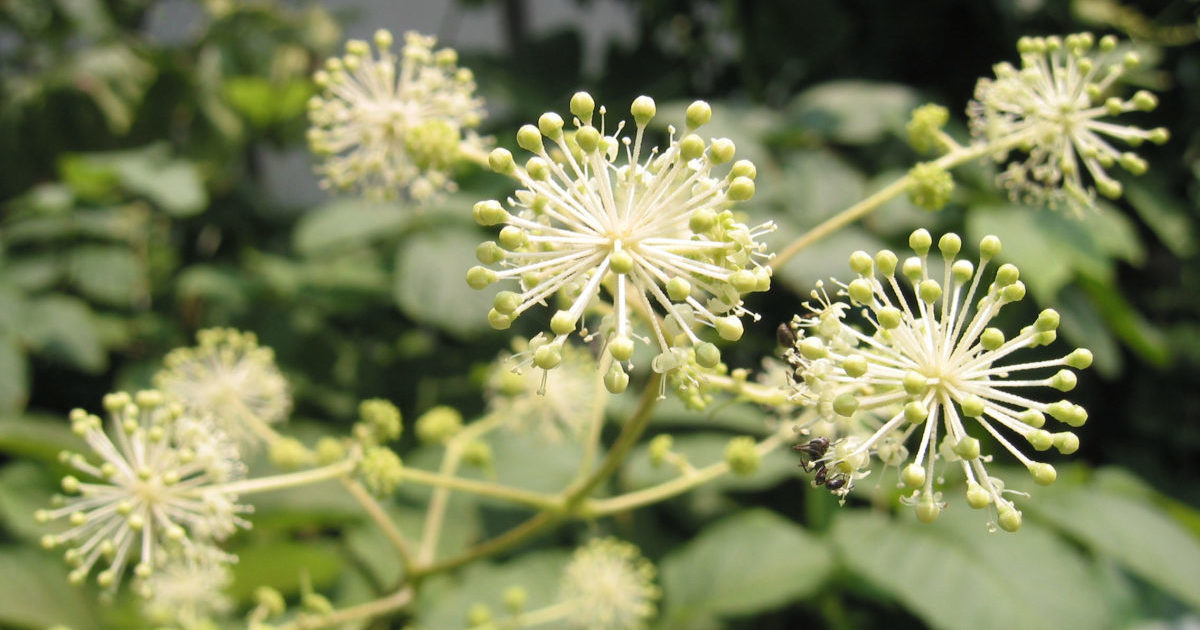 Aralia Manchurian - medicinal properties and contraindications, the use of tinctures in bodybuilding
Aralia Manchurian - medicinal properties and contraindications, the use of tinctures in bodybuilding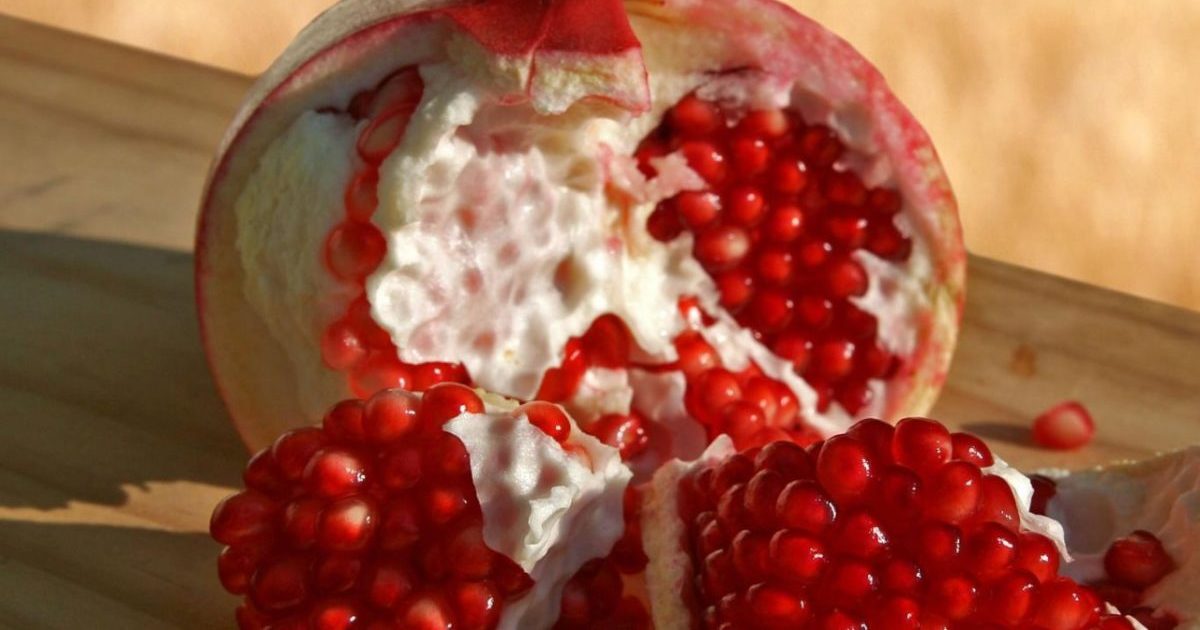 Seedless pomegranate - cutaway appearance, benefits and harms
Seedless pomegranate - cutaway appearance, benefits and harms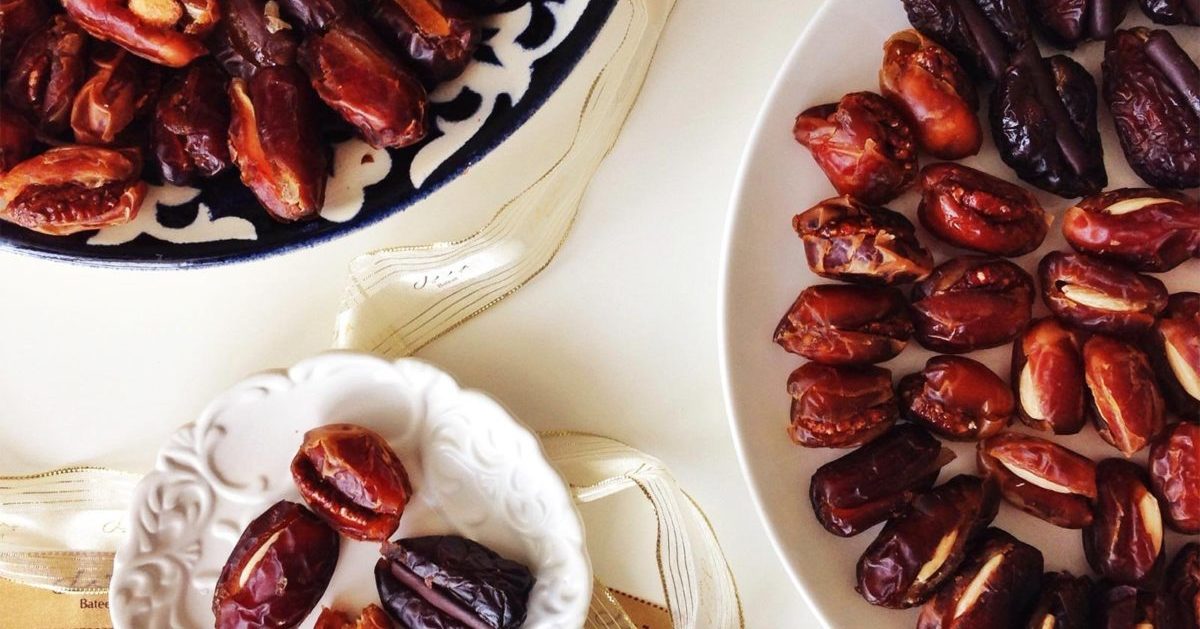 Dates - the benefits and harm to the body, how much you need to eat, properties and calorie content
Dates - the benefits and harm to the body, how much you need to eat, properties and calorie content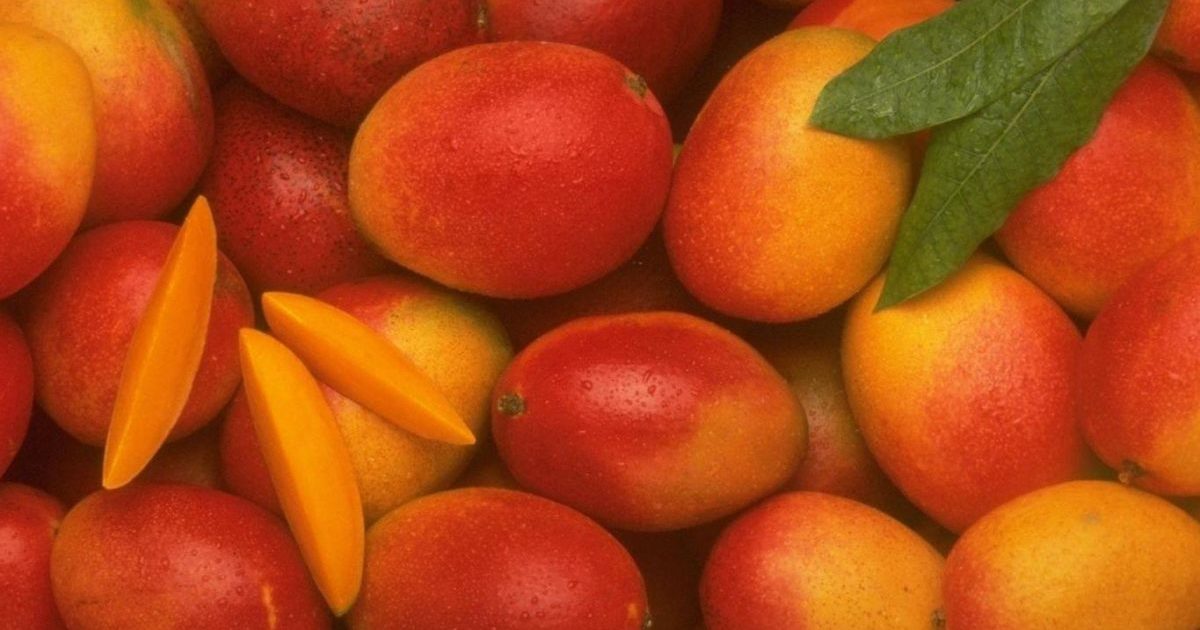 The benefits and harms of mango for the body of women and men - how to eat it?
The benefits and harms of mango for the body of women and men - how to eat it?
Valeri Mishnov
I grew conifers from seeds.Cedars, sequoia, Caucasian juniper and yew berry. Blue spruce stubbornly did not emerge. I asked my brother, who worked at the leskhoz, how they get blue spruce seedlings. He said, we are rooting the branches. I did not believe it, but when I cut the grown seedlings from the lower branches, I decided to try to root. Archa and yew rooted well in pots in a greenhouse. Today planted branches of cedar and sequoia. I hope for success.